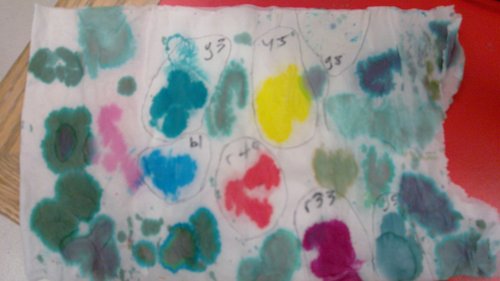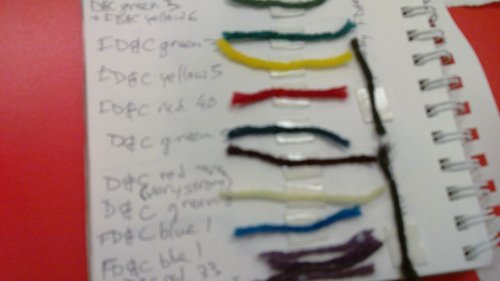I have, once again, been fiddling around with yarn and dye. This time, the particular dye I've been fiddling with is FD&C, as well as D&C compliant dye. Practically, it means two things: it's a material specified and regulated heavily; and you can put it on your body without killing yourself, to a certain extent. Food colouring, at least in powder form, tends to be acid dye, which means that it's happier in the presence of acids like citric or even vinegar. This dye, together with a little citric acid, can colour cosmetics, animal protein (wool, silk, human hair) and lots of other things, including the paper towel pictured below (Hint: the numbers and letter written next to the splotches are their names: FD&C Green #3, FD&C Yellow #5, FD&C Blue #1, FD&C Red #40, D&C Red #33, D&C Green #8, D&C Green #5). So, what exactly am I doing with this highly regulated, standardized dye which works on lots of things? Right now, I'm dying yarn. Give it a week and I'll be dying my hair. In the intervening time, I'll be breaking out my RGB sensor and capturing hex values for the yarn colours. I'm documenting pigment ratios, water temperature, water to pigment ratios, pigment to acid ratios and steeping time. All of this will go with those hex values I just mentioned. Together, they'll mean that anyone can convert an RGB colour into a physical yarn colour. Then I'll do the same for screen printing ink, then offset, then who knows what else. In the mean time, you can knit a sweater.
So, what exactly am I doing with this highly regulated, standardized dye which works on lots of things? Right now, I'm dying yarn. Give it a week and I'll be dying my hair. In the intervening time, I'll be breaking out my RGB sensor and capturing hex values for the yarn colours. I'm documenting pigment ratios, water temperature, water to pigment ratios, pigment to acid ratios and steeping time. All of this will go with those hex values I just mentioned. Together, they'll mean that anyone can convert an RGB colour into a physical yarn colour. Then I'll do the same for screen printing ink, then offset, then who knows what else. In the mean time, you can knit a sweater.

 So, what exactly am I doing with this highly regulated, standardized dye which works on lots of things? Right now, I'm dying yarn. Give it a week and I'll be dying my hair. In the intervening time, I'll be breaking out my RGB sensor and capturing hex values for the yarn colours. I'm documenting pigment ratios, water temperature, water to pigment ratios, pigment to acid ratios and steeping time. All of this will go with those hex values I just mentioned. Together, they'll mean that anyone can convert an RGB colour into a physical yarn colour. Then I'll do the same for screen printing ink, then offset, then who knows what else. In the mean time, you can knit a sweater.
So, what exactly am I doing with this highly regulated, standardized dye which works on lots of things? Right now, I'm dying yarn. Give it a week and I'll be dying my hair. In the intervening time, I'll be breaking out my RGB sensor and capturing hex values for the yarn colours. I'm documenting pigment ratios, water temperature, water to pigment ratios, pigment to acid ratios and steeping time. All of this will go with those hex values I just mentioned. Together, they'll mean that anyone can convert an RGB colour into a physical yarn colour. Then I'll do the same for screen printing ink, then offset, then who knows what else. In the mean time, you can knit a sweater.
Leave a comment